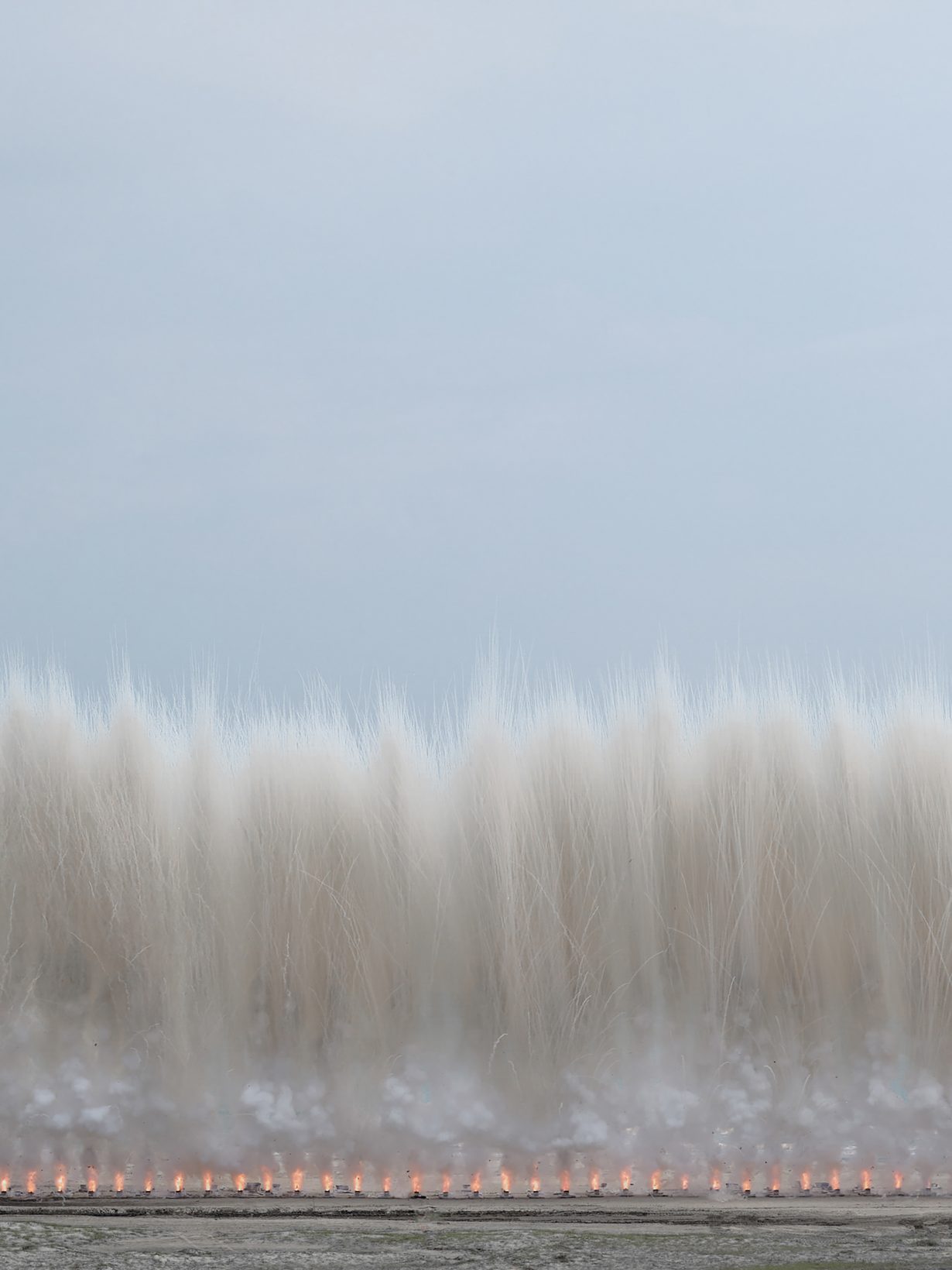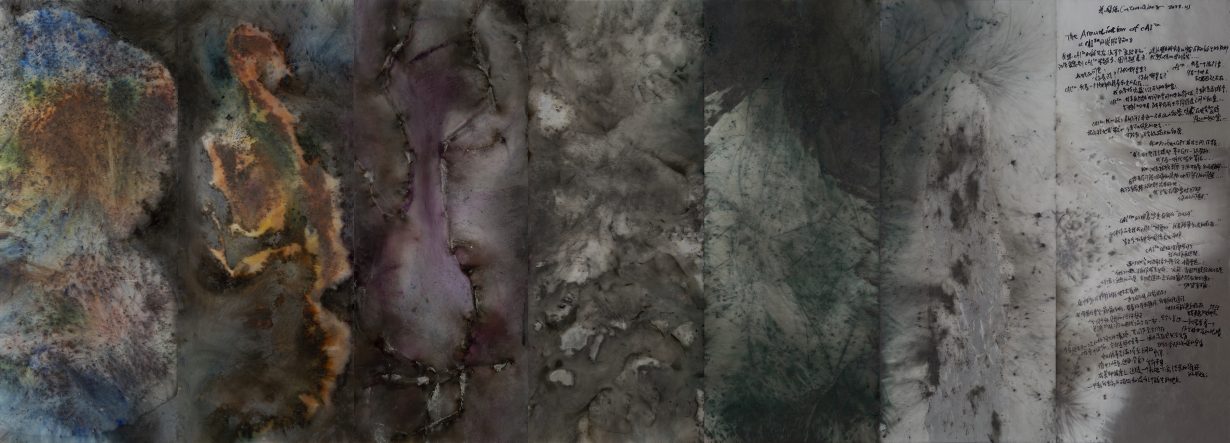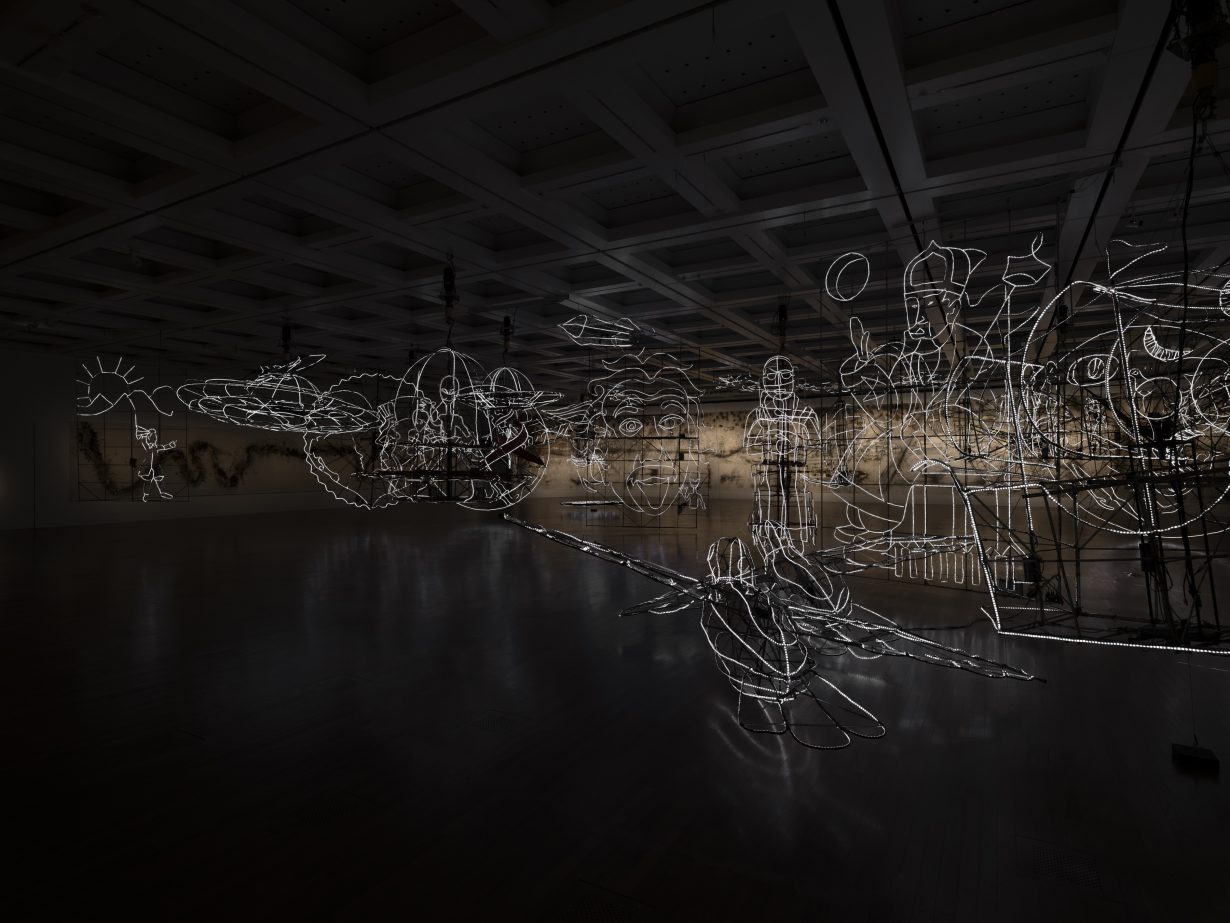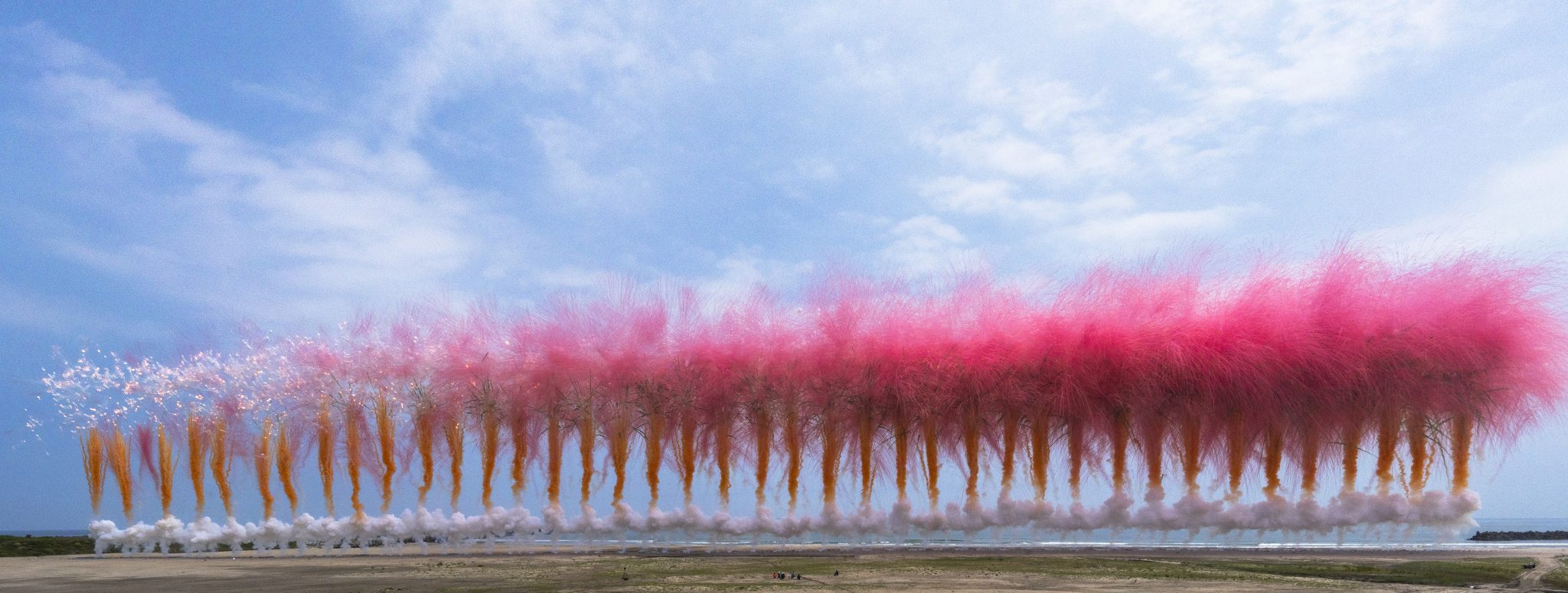How much fusewire does it take to set off enough explosives to highlight the contours of the Earth?
Cai Guo-Qiang is one of China’s best-known artists. While he is celebrated for his day- and nighttime firework performances (not least as part of the 2008 Olympic Games in Beijing), and related gunpowder drawings, his work also explores China’s historical past (exhibitions of his have been made in conjunction with figures from the ancient terracotta warriors; or in Beijing’s Forbidden City) and technological future (via virtual reality and the development of NFTs). In June the artist returned to Japan, where he had lived from 1986 to 1994 (before moving to New York), for a retrospective exhibition of his work at the National Art Center, Tokyo (NACT), titled Ramble in the Cosmos – From Primeval Fireball Onward, which was coorganised by Saint Laurent. The exhibition explores the constructive and destructive potential of explosions as well as the artist’s broader concerns with the nature of the universe in both its observable and unseen forms. It launched with a new daytime firework event titled When the Sky Blooms with Sakura, which was commissioned by the luxury fashion house and its creative director, Anthony Vaccarello. ArtReview Asia caught up with the artist shortly after the event.

ArtReview Asia Your explosion event When the Sky Blooms with Sakura revisits a coastline where you conducted a similar event 29 years ago. What has changed both in your work and in your relationship to fireworks in the years in between?
Cai Guo-Qiang There have been changes in the way I use gunpowder. In The Horizon from the Pan-Pacific: Project for Extraterrestrials No. 14 – an explosion event that was realised in Iwaki, Japan, almost 30 years ago – I twisted together six gun-powder fuses each measuring 5,000 metres, and the glaring flames of the gunpowder explosion outlined the contour of the Earth on the pitch-black sea. At that time, the work had a more extended dialogue with the public: local people responded to its spirit as a conversation with the universe, and they participated by purchasing fuses – which were selling for 1,000 yen per metre – as well as urging everyone to turn off the lights at home to collectively join the artwork.
When the Sky Blooms with Sakura was not directly based on the previous project but emerged after Project to Plant Ten Thousand Cherry Blossom Trees, which supported our friends in Iwaki after the 2011 earthquake, tsunami and nuclear accident. When it got to 2021, the [disasters’] tenth anniversary, I had the idea to work with the local people again on an explosion project, to make the sky blossom with cherry flowers, as a continuation of the previous project, which had ‘planted’ them. But because of the pandemic, it didn’t happen. This time, with the support of [fashion house] Saint Laurent, I went back to Iwaki’s Yotsukura coast – where I had realised The Horizon… – and once again cultivated my work there, producing Japan’s first daytime fireworks.
The change in this work also relates to my experience in the past few years. The 9/11 attack made me notice how daytime fireworks can be superimposed on nature and social reality, which allows the work greater conceptual potential. Nighttime fireworks realise various effects through light; they bloom brilliantly and then return to darkness. Daytime fireworks rely on smoke to take shape, and although they also pursue a certain poetics, they directly confront the naked social realities by superimposing on them.

ARA When the Sky Blooms in Sakura refers to a natural phenomenon, whereas fireworks are manmade. To what extent are you reflecting on these two worlds?
CGQ Cherry blossoms and fireworks have something in common: they are both shortlived. Of course, cherry blossoms last about a week or two, while fireworks last only a few seconds. In nature, although cherry blossoms are poetic, they are after all real objects, whereas fireworks can be more iconographical. In When the Sky Blooms with Sakura, whether it’s the white tsunami, the black waves, the monument or the cherry blossoms themselves, they all convey meanings conceptually through iconographies.
ARA Your current exhibition at the NACT is titled Ramble in the Cosmos – From Primeval Fireball Onward, which suggests a universal outlook and a relation to deep time. Can you explain what has influenced your thoughts on these subjects and how it manifests itself in your art? How does the explosive moment of the Big Bang relate to the use of explosives today? How does your work, and indeed your personal take on things, fit into the cosmic scale (the small – relatively – and the large)?
CGQ During the pandemic, I revisited my sketchbooks from the 1980s and 90s to connect with the state of mind I was in at that time. During my ‘Japan era’, I thought a lot about the human and global problems of the twentieth century, including material prosperity, the degradation of human nature, environmental destruction and the future of the cosmos – I pondered these issues as if I was an extraterrestrial. At that time, I was very close to the universe, and I often thought on cosmological scales and expressed myself in such terms. Based on the plans in my sketchbooks, I created several new gunpowder drawings and picked up on the Project for Extraterrestrials series again, which had been halted for many years – I returned to the embrace of the universe, which foreshadowed the Ramble in the Cosmos exhibition at the NACT this time. The title Primeval Fireball reflects my interpretation of Laozi’s ancient cosmology: ‘There was something nebulous yet complete, born before heaven and earth’ – a notion that perhaps also alluded to my emergence into the artworld?

ARA How have you grouped the works in the exhibition? Do you set out at the start of planning a show with a narrative in mind? Is that narrative internal or external to your art practice? And what is it that guides you to work in one medium over another?
CGQ The NACT exhibition traces my dialogues with the universe and the unseen world, from my creations and reflections during my early days in China, to Japan – which was an important formative stage in my artistic career – to my works in the United States and on the world stage. It posits my 1991 exhibition Primeval Fireball at P3 Art and Environment in Tokyo as a starting point, posing the questions: what triggered my ‘big bang’? What has occurred since then? Is the spirit of Primeval Fireball still alive?
Regarding the use of different mediums in my practice, it relates to the changes in my environment. The works from my ‘Chinese era’ were more ‘primitive’; they contain dialogues with the ancient times, as well as a universalist view on cosmology and the Earth, such as in The Earth is Our Common Home [1985]. When I got to Japan, I was influenced by the development of astrophysics and began preparing for the series Project for Extraterrestrials and Project for Humankind towards the end of the 1980s. At the same time, having observed Japanese society’s reflection upon its own Westernisation as a result of its century-long efforts into modernisation and globalisation, which brought about an overly polarised East vs West dichotomy, I put emphasis on thinking and creating works from the broader perspective of the universe and mankind.
After I went to New York in 1995, I naturally created more works on the themes of international politics and social problems. The same gunpowder gave rise to the ‘mushroom clouds’ I ignited at the Nevada Nuclear Test Site [in The Century with Mushroom Clouds: Project for the 20th Century, 1996]. My other installations, such as Bringing to Venice What Marco Polo Forgot at the 1995 Venice Biennale, Borrowing Your Enemy’s Arrows at New York’s Museum of Modern Art in 1998, Head On at Berlin’s Deutsche Guggenheim in 2006 and Heritage at Brisbane’s QAGOMA in 2013 – to name but a few – are all based on the themes of human destiny and social history. They reflected how my practice changed as I was nurtured in the Western cultural landscape.

ARA What’s it like to look back over your practice? Do you feel as close to the works you did in the past as you do to the works you’re making today? Do you think your influences have changed over time?
CGQ We have to accept our own changes with an honest and open mind. Indeed, you can’t always live in your childhood, as life will bring you more experience. But the main challenge is how to protect that childlike curiosity. It’s unnecessary and impossible for me to create a folding screen like the Primeval Fireball again, but today I can blast gunpowder on glass and mirrors, and work with AI. In the gallery, the three new folding screens made of glass and mirrors are a kind of continuation of my exploration of spirituality and illusion, as well as a continuation of the spirit of the Primeval Fireball.
ARA Do you see the ‘explosive moment’ as destructive or creative? There is a sense in which it wipes the slate clean, but also one in which it produces something new. Can it be both?
CGQ Actually both sides are present. The emergence of any energy is related to the principles of explosion. The energy of the explosion, from that of the Big Bang to that at the creation of particles, is all very similar. It is pure, and it represents an instantaneous spacetime. In my fireworks, what I really like are the explosions, with their abstract energy, unexpectedness, uncontrollability and sense of unease. In fact, for the daytime fireworks this time, as beautiful as they looked, they were also unsettling. Between the sunny sky and the ocean, the sound and energy generated by the explosion were so shocking… the unease and excitement brought emotions and memories. The energy of art often contains an intrusiveness to people as well, so it is important for artists to gauge that ‘degree’ and distance.
ARA While this exhibition points to an originary moment in the past, much of your recent work has explored ‘new’ technology, from NFTs to VR. Are new technologies a way of expanding your audience or do they offer other new possibilities as well?
CGQ Since 2017 I have been continuously exploring the new possibilities of contemporary art through cutting-edge technologies such as AI, AR, VR, blockchain and NFT. The internet is driving the globalisation, digitalisation and intelligent revolution, including AI, at an unprecedented speed, triggering rapid changes in social forms and lifestyles. In 1990 I wrote in my diary, ‘Being in the beginning of the computer and information age, I am excited as an artist to be part of this great transformation. Compared to the Impressionists facing the development of human industrial civilisation, we are facing a more essential and magnificent era of humanity. This self-awareness makes me feel the need to strive hard.’ Now, advanced technologies like AI once again excite me, and I always feel fortunate to be living in such an era!
The emergence of various digital tools and AI excites me, as it might serve as a catalyst for embracing a brand-new artistic methodology. It compels artists to contemplate fresh creative directions. Reflecting upon the progression of human society, we can observe that whenever humanity faces significant conceptual and technological breakthroughs, be it during the era of religious reform, the Industrial Revolution, the early days of photography or the advent of television, each of these epochs has fostered new artistic possibilities. However, I remain ambivalent: is this metaphor an exaggeration or an understatement? Today, what’s important is not what AI can help humans with. What’s important with AI is what defines humanity? What ought humans to do?

ARA You’ve lived within and engaged with the histories of many cultures around the world, and during that time there has been much talk about a global artworld, where works can be transported from one end of the world to the other, and somehow remain the same (in terms of meaning and affect). Do you believe that’s true or even desirable? And to what extent do you intend to carry a certain ‘Chineseness’ with you as you show around the world, and what might that ‘Chineseness’ be?
CGQ I am like a seed sprinkled in the soil of different cultures, but I don’t avoid the fact that, as an artist of Chinese origin, there are cultural constants in my methodology. Although these constants are not the purpose or content of what I set out to show, they can flow out naturally.
In the runup to the Doha project in 2011, I was nervous that I didn’t know much about Arab culture, nor did I know where to start. Eventually I decided to start with the Muslim cemeteries in my hometown of Quanzhou. I used the opportunity to learn about the texts written on these tombstones that I could not read, many of which were extracts from the Quran and the Prophet Muhammad’s sayings. Feeling the spiritual connection of the Muslim community – who have lived in Quanzhou for over a thousand years – to their homeland, I made the installation Homecoming [2011], which consisted of 60 boulders. On these boulders found in my hometown, I engraved the words from the Muslim tombstones that touched my heart. I transported the stones to Doha, where I performed a homecoming ceremony for these ‘Fellows from Quanzhou’ who died in a foreign land.
As for Chinese culture, I was mostly left with the many memories of my hometown, and I think of them at different times. These things are inseparable from my childhood curiosity and the customs of my hometown. While I’m not trying to show my home culture, I don’t have to shy away from it either. Based on my artmaking in different lands, I transformed the customs of my hometown into dialogues with the local cultures. I’m attracted to this kind of creative process, and it is more natural and honest.
ARA What’s influencing you at the moment? What issues most concern you, and what’s next for you?
CGQ Curiosity about the unknown and a playful attitude towards art are my motivations. New challenges unsettle me and bring me uncontrollability, but they also bring surprise and excitement. New ideas and technologies do the same to human civilisation. Humans discovered the use of fire and our civilisation made a great leap; humans invented gunpowder and then nuclear energy… and now humans face the same fear and anxiety with AI. But still, humankind doesn’t put the brakes on, but instead faces those challenges.
I usually spend a lot of time setting up an exhibition before the opening. I also hope to go back before it closes and walk from the entrance to the exit to have a grasp of the energy of the gallery as a spectator in search of new feelings that are bred inside the exhibition. This process will be good for my next steps, because in a way all the works and exhibitions are the preparation sketches for the next ones.
I remember Francesca Bellettini, the CEO of Saint Laurent, telling me that Japanese culture had also deeply influenced Mr Saint Laurent, so the collaboration with the brand here is somehow appropriate. With that in mind, I would like to express my gratitude to Anthony Vaccarello, Saint Laurent’s creative director, who has not only continued the brand’s tradition of collaborating with a diverse range of artists, but has also initiated a revolutionary commitment to creative excellence that crosses over from fashion to film, music and beyond.
Ramble in the Cosmos – From Primeval Fireball Onward is on view at the National Art Center, Tokyo (NACT) through 21 August. It has been organised by the NACT and Saint Laurent
